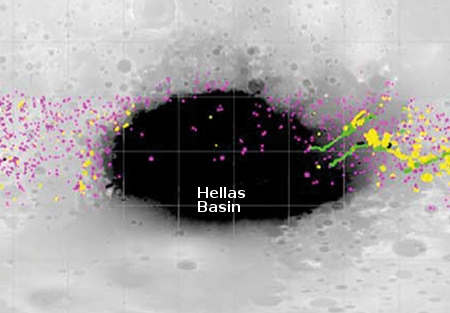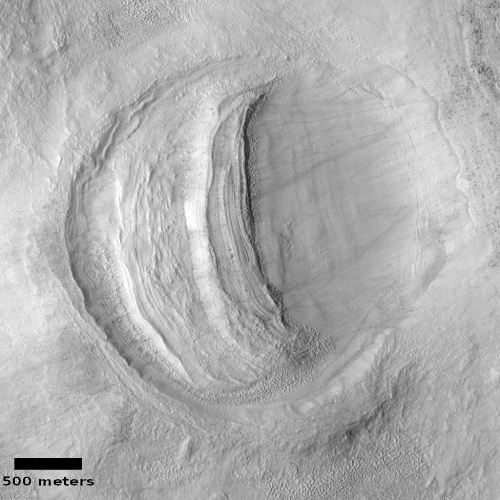Strange crater in the basement of Mars
Today’s cool image to the right, cropped and reduced to post here, is intriguing for a number of reasons. Taken on September 11, 2020 by the high resolution camera on Mars Reconnaissance Orbiter (MRO), it shows a partially buried crater found in the middle of Hellas Basin, the lowest point on Mars and what I like to call the red planet’s basement.
What makes this crater intriguing is the layered pile of material filling its interior. If I didn’t know any better, I would think some construction crew has used a bulldozer to push debris from the crater’s right half in order to smooth the ground in preparation for building a strip mall, office building, or housing development.
This of course is not what happened. Then what did create those layered piles in the crater’s left half?

The crater is at 37 degrees south latitude, which puts it in the mid-latitude bands where scientists have found lots of evidence of glacial material. As I noted, however, it is also deep inside Hellas Basin, which because of the low elevation appears to reduce the number of identified glacial features, as shown in the figure to the right, taken from a 2019 paper describing those glacial bands. The green and yellow markers show the location of glacial features that are in many ways most similar to glaciers found on Earth, flows heading downhill along natural geographic features. The magenta marks craters that appear to have buried ice on their inside, the category in which today’s crater would likely fall.
Note how few markers there are inside Hellas. It appears the lower elevation, like on Earth, discourages the long term existence of ice. Moreover, Hellas Basin itself has many fewer craters than the surrounding cratered highlands. It could be that craters in Hellas routinely contain glacial material also, but there just are fewer craters.
The material in the interior of this particular crater does resemble the kind of glacial features found in craters all along those mid-latitude bands. The layers indicate the ebb and flow of the red planet’s climate cycles produced by the known cyclic changes in its tilt towards the Sun, ranging from 11 to 60 degrees. With each cycle ice would either be deposited or sublimated away, causing these layers.
None of this however answers my first question above: Why is this debris piled up to the west as it is?
The east-west dark streaks inside the crater indicate the passage of dust devils and also indicate the orientation of the prevailing winds. It is possible that the faint wind of the thin Martian atmosphere could over enough time move material into these piles, though if it did one would expect the pile to look more like dunes and not layered debris.
The simple answer: I don’t know, and unfortunately the scientist who requested this image and would have a better understanding of the geology has not responded to my emails.
On Christmas Eve 1968 three Americans became the first humans to visit another world. What they did to celebrate was unexpected and profound, and will be remembered throughout all human history. Genesis: the Story of Apollo 8, Robert Zimmerman's classic history of humanity's first journey to another world, tells that story, and it is now available as both an ebook and an audiobook, both with a foreword by Valerie Anders and a new introduction by Robert Zimmerman.
The print edition can be purchased at Amazon or from any other book seller. If you want an autographed copy the price is $60 for the hardback and $45 for the paperback, plus $8 shipping for each. Go here for purchasing details. The ebook is available everywhere for $5.99 (before discount) at amazon, or direct from my ebook publisher, ebookit. If you buy it from ebookit you don't support the big tech companies and the author gets a bigger cut much sooner.
The audiobook is also available at all these vendors, and is also free with a 30-day trial membership to Audible.
"Not simply about one mission, [Genesis] is also the history of America's quest for the moon... Zimmerman has done a masterful job of tying disparate events together into a solid account of one of America's greatest human triumphs."--San Antonio Express-News
Today’s cool image to the right, cropped and reduced to post here, is intriguing for a number of reasons. Taken on September 11, 2020 by the high resolution camera on Mars Reconnaissance Orbiter (MRO), it shows a partially buried crater found in the middle of Hellas Basin, the lowest point on Mars and what I like to call the red planet’s basement.
What makes this crater intriguing is the layered pile of material filling its interior. If I didn’t know any better, I would think some construction crew has used a bulldozer to push debris from the crater’s right half in order to smooth the ground in preparation for building a strip mall, office building, or housing development.
This of course is not what happened. Then what did create those layered piles in the crater’s left half?

The crater is at 37 degrees south latitude, which puts it in the mid-latitude bands where scientists have found lots of evidence of glacial material. As I noted, however, it is also deep inside Hellas Basin, which because of the low elevation appears to reduce the number of identified glacial features, as shown in the figure to the right, taken from a 2019 paper describing those glacial bands. The green and yellow markers show the location of glacial features that are in many ways most similar to glaciers found on Earth, flows heading downhill along natural geographic features. The magenta marks craters that appear to have buried ice on their inside, the category in which today’s crater would likely fall.
Note how few markers there are inside Hellas. It appears the lower elevation, like on Earth, discourages the long term existence of ice. Moreover, Hellas Basin itself has many fewer craters than the surrounding cratered highlands. It could be that craters in Hellas routinely contain glacial material also, but there just are fewer craters.
The material in the interior of this particular crater does resemble the kind of glacial features found in craters all along those mid-latitude bands. The layers indicate the ebb and flow of the red planet’s climate cycles produced by the known cyclic changes in its tilt towards the Sun, ranging from 11 to 60 degrees. With each cycle ice would either be deposited or sublimated away, causing these layers.
None of this however answers my first question above: Why is this debris piled up to the west as it is?
The east-west dark streaks inside the crater indicate the passage of dust devils and also indicate the orientation of the prevailing winds. It is possible that the faint wind of the thin Martian atmosphere could over enough time move material into these piles, though if it did one would expect the pile to look more like dunes and not layered debris.
The simple answer: I don’t know, and unfortunately the scientist who requested this image and would have a better understanding of the geology has not responded to my emails.
On Christmas Eve 1968 three Americans became the first humans to visit another world. What they did to celebrate was unexpected and profound, and will be remembered throughout all human history. Genesis: the Story of Apollo 8, Robert Zimmerman's classic history of humanity's first journey to another world, tells that story, and it is now available as both an ebook and an audiobook, both with a foreword by Valerie Anders and a new introduction by Robert Zimmerman.
The print edition can be purchased at Amazon or from any other book seller. If you want an autographed copy the price is $60 for the hardback and $45 for the paperback, plus $8 shipping for each. Go here for purchasing details. The ebook is available everywhere for $5.99 (before discount) at amazon, or direct from my ebook publisher, ebookit. If you buy it from ebookit you don't support the big tech companies and the author gets a bigger cut much sooner.
The audiobook is also available at all these vendors, and is also free with a 30-day trial membership to Audible.
"Not simply about one mission, [Genesis] is also the history of America's quest for the moon... Zimmerman has done a masterful job of tying disparate events together into a solid account of one of America's greatest human triumphs."--San Antonio Express-News



If this were on earth, I’d suspect that this is the core of an eroded crater, and we’re looking at previously tilted basement rocks beneath the impact’s severe damage zone. The surrounding landscape would have also eroded downward – so we’re seeing only the lower portions of the crater wall and underlying tilted basement. Surface ejecta long gone. Of course, this isn’t earth . . .